- Home
- Jared Diamond
The Rise and Fall of the Third Chimpanzee Page 29
The Rise and Fall of the Third Chimpanzee Read online
Page 29
Finally, domestication requires being able to breed an animal in captivity. As zoos often discover to their dismay, captive animals that are docile and healthy may nevertheless refuse to breed in cages. You yourself would not want to carry out a lengthy courtship and copulate under the watchful eyes of others; many animals do not want to either.
This problem has derailed persistent attempts to domesticate some potentially very valuable animals. For example, the finest wool in the world comes from the vicuña, a small camel species native to the Andes. But neither the Incas nor modern ranchers have ever been able to domesticate it, and wool must still be obtained by capturing wild vicuñas. Many potentates, from ancient Assyrian kings to nineteenth-century Indian maharajahs, have tamed cheetahs, the world’s swiftest land mammal, for hunting. However, every prince’s cheetah had to be captured from the wild, and not even zoos were able to breed them until 1960.
Collectively, these reasons help explain why Eurasians succeeded in domesticating the Big Five but not other closely related species, and why American Indians did not domesticate bison, peccaries, tapirs, and mountain sheep or goats. The military value of the horse is especially interesting in illustrating what seemingly slight differences make one species uniquely prized, another useless. Horses belong to the group of mammals termed Perissodactyla, which consists of the hoofed mammals with an odd number of toes: horses, tapirs, and rhinoceroses. Of the seventeen living species of Perissodactyla, all four tapirs and all five rhinos, plus five of the eight wild horse species, have never been domesticated. Africans or Indians mounted on rhinos or tapirs would have trampled any European invaders, but it never happened.
A sixth wild horse relative, the wild ass of Africa, gave rise to domestic donkeys, which proved splendid as pack animals but useless as military chargers. The seventh wild horse relative, the onager of western Asia, may have been used to pull wagons for some centuries after 3000 BC. But all accounts of the onager blast its vile disposition with adjectives like ‘bad-tempered’, ‘irascible’, ‘unapproachable’, ‘unchangeable’, and ‘inherently intractable’. The vicious beasts had to be kept muzzled to prevent them from biting their attendants. When domesticated horses reached the Middle East around 2300 BC, onagers were finally kicked onto the scrapheap of failed domesticates.
Horses revolutionized warfare in a way that no other animal, not even elephants or camels, ever rivalled. Soon after their domestication, they may have enabled herdsmen speaking the first Indo-European languages to begin the expansion that would eventually stamp their languages on much of the world (Chapter Fifteen). A few millenia later, hitched to battle chariots, horses became the unstoppable Sherman tanks of ancient war. After the invention of saddles and stirrups, they enabled Attila the Hun to devastate the Roman Empire, Genghis Khan to conquer an empire from Russia to China, and military kingdoms to arise in West Africa. A few dozen horses helped Cortes and Pizarro, leading only a few hundred Spaniards each, to overthrow the two most populous and advanced New World states, the Aztec and Inca empires. With futile Polish cavalry charges against Hitler’s invading armies in September 1939, the military importance of this most universally prized of all domestic animals finally came to an end after 6,000 years.
Ironically, relatives of the horses that Cortes and Pizarro rode had formerly been native to the New World. Had those horses survived, Montezuma and Atahuallpa might have shattered the conquistadores with cavalry charges of their own. But, in a cruel twist of fate, America’s horses had become extinct long before that, along with eighty or ninety per cent of the other large animal species of the Americas and Australia. It happened around the time that the first human settlers – ancestors of modern Indians and native Australians – reached those continents. The Americas lost not only their horses but also other potentially domesticatable species like large camels, ground sloths, and elephants. Australia lost all its giant kangaroos, giant wombats, and rhinoceros-like diprotodonts. Australia and North America ended up with no domesticatable mammal species at all, unless Indian dogs were derived from North American wolves. South America was left with only the guinea-pig (used for food), alpaca (used for wool), and llama (used as a pack animal, but too small to carry a rider).
As a result, domestic mammals made no contribution to the protein needs of native Australians and Americans except in the Andes, where their contribution was still much slighter than in the Old World. No native American or Australian mammal ever pulled a plough, cart, or war chariot, gave milk, or bore a rider. The civilizations of the New World limped forward on human muscle power alone, while those of the Old World ran on the power of animal muscle, wind, and water.
Scientists still debate whether the prehistoric extinctions of most large American and Australian mammals were due to climatic factors or were caused by the first human settlers themselves (Chapters Seventeen to Nineteen). Whichever was the case, the extinctions may have virtually ensured that the descendants of those first settlers would be conquered over 10,000 years later by people from Eurasia and Africa, the continents that retained most of their large mammal species.
*
Do similar arguments apply to plants? Some parallels jump out immediately. As true of animals, only a tiny fraction of all wild plant species have proved suitable for domestication. For example, plant species in which a single hermaphroditic individual can pollinate itself (like wheat) were domesticated earlier and more easily than cross-pollinated species (like rye). The reason is that self-pollinating varieties are easier to select and then maintain as true strains, since they are not continually mixing with their wild relatives. As another example, although acorns of many oak species were a major food source in prehistoric Europe and North America, no oak has ever been domesticated, perhaps because squirrels remained much better than humans at selecting and planting acorns. For every domesticated plant that we still use today, many others were tried in the past and discarded. (What living American has eaten sumpweed, which Indians in the eastern US domesticated for its seeds by around 2000 BC?)
Such considerations help explain the slow rate of human technological development in Australia. That continent’s relative poverty in wild plants appropriate for domestication, as in appropriate wild animals, undoubtedly contributed to the failure of aboriginal Australians to develop agriculture. But it is not so obvious why agriculture in the Americas lagged behind that in the Old World. After all, many food plants now of worldwide importance were domesticated in the New World: corn, potatoes, tomatoes, and squash, to name just a few. The answer to this puzzle requires closer scrutiny of corn, the New World’s most important crop.
Corn is a cereal – that is, a grass with edible starchy seeds, like barley kernels or wheat grains. Cereals still provide most of the calories consumed by the human race. While all civilizations have depended on cereals, different native cereals have been domesticated by different civilizations: for instance, wheat, barley, oats, and rye in the Near East and Europe; rice, foxtail millet, and broomcorn millet in China and Southeast Asia; sorghum, pearl millet, and finger millet in sub-Saharan Africa; but only corn in the New World. Soon after Columbus discovered America, corn was brought back to Europe by early explorers and spread around the globe, and it now exceeds all other crops except wheat in world acreage planted. Why, then, did corn not enable American Indian civilizations to develop as fast as the Old World civilizations fed by wheat and other cereals?
It turns out that corn was a much bigger pain in the neck to domesticate and grow, and gave an inferior product. Those will be fighting words to all of you who, like me, love hot, buttered corn-on-the-cob. Throughout my childhood, I looked forward to late summer as the season to stop at roadside stands and pick out the best-looking fresh ears. Corn is the most important crop in the US today, worth twenty-two billion dollars to us and fifty billion dollars to the world. But before you charge me with slander, please hear me out on the differences between corn and other cereals.
The Old World had over a dozen wild
grasses that were easy to domesticate and grow. Their large seeds, favoured by the Near East’s highly seasonal climate, made their value obvious to incipient farmers. They were easy to harvest en masse with a sickle, easy to grind, easy to prepare for cooking, and easy to sow. Another subtle advantage was first recognized by University of Wisconsin botanist Hugh Iltis: we did not have to figure out for ourselves that they could be stored, since wild rodents in the Near East already made caches of up to sixty pounds of those wild grass seeds.
The Old World grains were already productive in the wild, and one can still harvest up to 700 pounds of grain per acre from wild wheat growing naturally on hillsides in the Near East. In a few weeks a family could harvest enough to feed itself for a year. Even before wheat and barley were domesticated, there were sedentary villages in Palestine that had already invented sickles, mortars and pestles, and storage pits, and that were supporting themselves on wild grains.
Domestication of wheat and barley was not a conscious act. It was not the case that several hunter–gatherers sat down one day, mourned the extinction of big game animals, discussed which particular wheat plants were best, planted the seeds of those plants, and thereby became farmers the next year. Instead, as I mentioned in Chapter Ten, the process we call domestication – the changes in wild plants under cultivation – was an unintended by-product of people preferring some wild plants over others, and hence accidentally spreading seeds of the preferred plants. In the case of wild cereals, people naturally preferred to harvest ones with big seeds, ones whose seeds were easy to remove from the seed-coverings, and ones with firm non-shattering stalks that held all the seeds together. It took only a few mutations, favoured by this unconscious human selection, to produce the large-seeded, non-shattering cereal varieties that we refer to as domesticated rather than wild.
By around 8000 BC, wheat and barley remains from archaeological digs at ancient Near Eastern village sites are beginning to show these changes. The development of bread wheats, other domestic varieties, and intentional sowing soon followed. Gradually, fewer remains of wild foods are found at the sites. By 6000 BC, crop cultivation had been integrated with animal herding into a complete food production system in the Near East. For better or worse (in some major respects worse, as I argued in Chapter Ten), people were no longer hunter–gatherers but farmers and herders, en route to being civilized.
Now contrast these relatively straightforward Old World developments with what happened in the New World. The parts of the Americas where farming began lacked the Near East’s highly seasonal climate, and so lacked large-seeded grasses that were already productive in the wild. North American and Mexican Indians did start to domesticate three small-seeded wild grasses called maygrass, little barley, and a wild millet, but these were displaced by the arrival of corn and then of European cereals. Instead, the ancestor of corn was a Mexican wild grass that did have the advantage of big seeds but in other respects hardly seemed like a promising food plant: annual teosinte.
Teosinte ears look so different from corn ears that scientists argued about teosinte’s precise role in corn’s ancestry till recently, and even now some scientists remain unconvinced. No other crop underwent such drastic changes on domestication as did teosinte. It has only six to twelve kernels per ear, and they are inedible, because they are enclosed in stonehard cases. One can chew teosinte stalks like sugar cane, as Mexican farmers still do. But no one uses its seeds today, and there is no indication that anyone did prehistorically either.
Hugh Iltis identified the key step in teosinte’s becoming useful: a permanent sex change! In teosinte the side branches end in a tassel composed of male flowers; in corn they end in a female structure, the ear. Although that sounds like a drastic difference, it is really a simple hormonally-controlled change that could have been started by a fungus, virus, or change in climate. Once some flowers on the tassel had changed sex to female, they would have produced edible naked grains likely to catch the attention of hungry hunter-gatherers. The tassel’s central branch would then have been the beginning of a corn cob. Early Mexican archaeological sites have yielded remains of tiny ears, barely an inch-and-a-half long and much like the tiny ears of our ‘Tom Thumb’ corn variety.
With that abrupt sex change, teosinte (alias corn) was now finally on the road to domestication. However, in contrast to the case with Near Eastern cereals, thousands of years of development still lay ahead before high-yield corns capable of sustaining villages or cities resulted. The final product was still much more difficult for Indian farmers to manage than were the cereals of Old World farmers. Corn ears had to be harvested individually by hand, rather than en masse with a sickle; the cobs had to be shucked; the kernels did not fall off but had to be scraped or bitten off; and sowing the seeds involved planting them individually, rather than scattering them en masse. The result was still poorer nutritionally than Old World cereals: lower protein content, deficiencies of nutritionally important amino acids, deficiency of the vitamin niacin (tending to cause the disease pellagra), and need for alkali treatment of the grain to partially overcome these deficiencies.
In short, characteristics of the New World’s staple food crop made its potential value much harder to discern in the wild plant, harder to develop by domestication, and harder to extract even after domestication. Much of the lag between New World and Old World civilization may have been due to those peculiarities of one plant.
*
So far, I have discussed geography’s biogeographic role, in providing the local wild animal and plant species suitable for domestication. But there is another major role of geography that deserves mention. Each civilization has depended not only on its own food plants domesticated locally, but also on other food plants that arrived after having been first domesticated elsewhere. The predominantly north/south axis of the New World made such diffusion of food plants difficult; the predominantly east/west axis of the Old World made it easy (see map).
Today, we take plant diffusion so much for granted that we seldom stop to think where our foods originated. A typical American or European meal might consist of chicken (of Southeast Asian origin) with corn (from Mexico) or potatoes (from the southern Andes), seasoned with pepper (from India), accompanied by a piece of bread (from Near Eastern wheat) and butter (from Near Eastern cattle), and washed down by a cup of coffee (from Ethiopia). But this diffusion of valued plants and animals did not begin just in modern times: it has been happening for thousands of years.
AXES OF THE OLD AND NEW WORLDS
Plants and animals spread quickly and easily within a climate zone to which they are already adapted. To spread out of this zone, they have to develop new varieties with different climate tolerances. A glance at the map of the Old World on this page shows how species could shift long distances without encountering a change of climate. Many of these shifts proved enormously important in launching farming or herding in new areas, or enriching it in old areas. Species moved between China, India, the Near East, and Europe without ever leaving temperate latitudes of the northern hemisphere. Ironically, the US patriotic song ‘America the Beautiful’ invokes America’s own spacious skies, its amber waves of grain. In reality, the most spacious skies of the northern hemisphere were in the Old World, where amber waves of related grains came to stretch for 7,000 miles from the English Channel to the China Sea.
The Romans were already growing wheat and barley from the Near East, peaches and citrus fruits from China, cucumbers and sesame from India, and hemp and onions from central Asia, along with oats and poppies originating locally in Europe. Horses that spread from the Near East to West Africa revolutionized military tactics there, while sheep and cattle spread down the highlands of East Africa to launch herding in southern Africa among the Hottentots, who lacked locally domesticated animals of their own. African sorghum and cotton reached India by around 2000 BC, while bananas and yams from tropical Southeast Asia crossed the Indian Ocean to enrich agriculture in tropical Africa.
In the New World, however, the temperate zone of North America is isolated from the temperate zone of the Andes and southern South America by thousands of miles of tropics, in which temperate-zone species cannot survive. As a result, the llama, alpaca, and guinea-pig of the Andes never spread in prehistoric times to North America or even to Mexico, which consequently remained without any domestic mammals to carry packs or to produce wool or meat (except for corn-fed edible dogs). Potatoes also failed to spread from the Andes to Mexico or North America, while sunflowers never spread from North America to the Andes. Many crops that were apparently shared prehistorically between North and South America actually occurred as different varieties or even species in the two continents, suggesting that they were domesticated independently in both areas. This seems true, for instance, of cotton, beans, lima beans, chili peppers, and tobacco. Corn did spread from Mexico to both North and South America, but it evidently was not easy, perhaps because of the time it took to develop varieties suited to other latitudes. Not until around 900 AD – thousands of years after corn had emerged in Mexico – did corn become a staple food in the Mississippi Valley, thereby triggering the belated rise of the mysterious mound-building civilization of the American Midwest.
Thus, if the Old and New Worlds had each been rotated ninety degrees about their axes, the spread of crops and domestic animals would have been slower in the Old World, faster in the New World. The rates of rise of civilization would have been correspondingly different. Who knows whether that difference would have sufficed to let Montezuma or Atahuallpa invade Europe, despite their lack of horses?
*
I have argued, then, that continental differences in the rates of rise of civilization were not an accident caused by a few individual geniuses. They were not produced by the biological differences determining the outcome of competition among animal populations – for example, some populations being able to run faster or digest food more efficiently than others. They also were not the result of average differences among whole peoples in inventiveness; there is no evidence for such differences anyway. Instead, they were determined by biogeography’s effect on cultural development. If Europe and Australia had exchanged their human populations twelve thousand years ago, it would have been the former native Australians, transplanted to Europe, who eventually invaded America and Australia from Europe.

 Why Is Sex Fun?: The Evolution of Human Sexuality
Why Is Sex Fun?: The Evolution of Human Sexuality Guns, Germs, and Steel: The Fates of Human Societies
Guns, Germs, and Steel: The Fates of Human Societies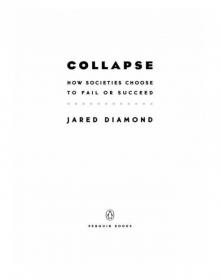 Collapse: How Societies Choose to Fail or Succeed
Collapse: How Societies Choose to Fail or Succeed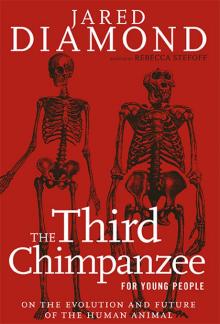 The Third Chimpanzee: The Evolution and Future of the Human Animal
The Third Chimpanzee: The Evolution and Future of the Human Animal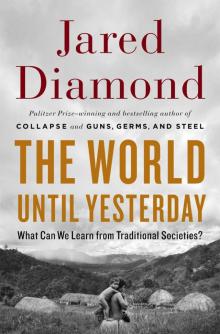 The World Until Yesterday: What Can We Learn From Traditional Societies?
The World Until Yesterday: What Can We Learn From Traditional Societies?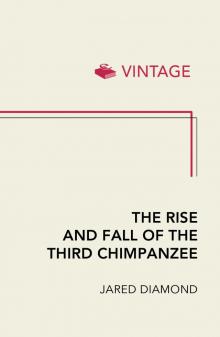 The Rise and Fall of the Third Chimpanzee
The Rise and Fall of the Third Chimpanzee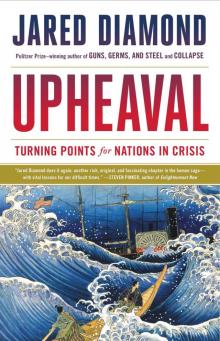 Upheaval: Turning Points for Nations in Crisis
Upheaval: Turning Points for Nations in Crisis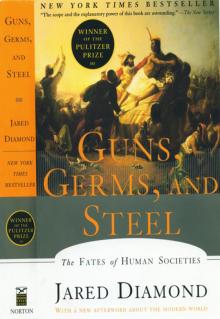 Guns, Germs, and Steel
Guns, Germs, and Steel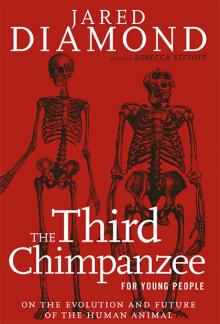 The Third Chimpanzee for Young People
The Third Chimpanzee for Young People Why Is Sex Fun?
Why Is Sex Fun?